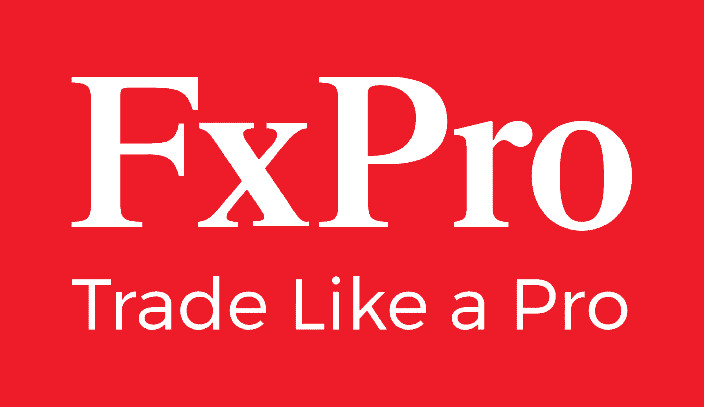CFD Broker for Beginners and Advanced Traders
The CFD broker handles all your orders, transmitting them to the exchange or executing them internally. This includes buying or selling shares, currencies, warrants, or CFDs.
Trading on exchanges or with CFDs is not possible without a broker.
To facilitate trading via your broker, they provide you with trading software. In the book and in the videos on the website, we use MetaTrader version 5, the widely used platform offering many exciting functions completely free of charge.
After opening a trading account, you can easily download the fully configured trading software from your broker for free and start trading immediately.
FxPro
- One of the pioneers in CFD trading and has been on the market since 1999.
- Multiple awards: has received constant recognition in the industry, winning over 123 international awards to 2025
- 11,200,000+ clients and it currently serves 173 countries worldwide. FxPro is one of the largest brokers in the world
- 786,000,000 Orders executed to date by 100.000s of traders
- FxPro is well-known throughout the industry as a trustworthy and reliable broker. They are international regulated by the FCA, CySEC, FSCA and SCB
- 5-star multilingual customer service team works 24/5 to provide you with an exceptional level of support
- More than 2,100 trading instruments, including CFDs on shares (e.g. NVIDIA, Tesla, Amazon), commodities (e.g. gold, silver, ...) and indices (e.g. S&P500)
- Low fees
- Cryptocurrencies such as Bitcoin and Ethereum can also be traded
- Instant account opening and verification
- Instant withdrawals of your profits
- Unlimited, free demo account for risk-free practice
- You receive the most popular trading platform, Metatrader free of charge after registration.
Here is a short video tutorial for you, on how to open a trading account and install the free trading software Metatrader in less than 10 minutes.
Frequently Asked Questions about CFD Brokers
What is a Broker?
The broker acts as an intermediary between you and the markets. In CFD trading, the broker functions as a market maker, immediately executing your orders as you trade directly with the provider. It's as if the market maker buys all the shares you want to trade instantly.
The broker hedges your open positions according to their risk specifications on the real stock exchange.
What can I Trade with CFDs?
CFDs are incredibly flexible financial instruments, allowing you to trade virtually anything, including:
- Shares like Amazon or Apple
- Country Indices like the FTSE100, ASX200, TSX, DAX or the S&P500
- Commodities like gold, silver or oil
- Digital assets like Bitcoin or Ethereum
What Costs will I Incur?
The trading account and the MetaTrader 4 or 5 trading software are entirely free of charge.
Trading fees, also known as spreads, are the costs incurred while trading. These fees are a small portion of each transaction and vary for each financial instrument. You can find the details in the fee schedule.
Note: The demo account can be used free of charge for an unlimited period.
How Long Does It Take to Open a CFD Trading Account?
Less than 10 minutes.
What is the Risk Disclosure?
When opening a trading account with a CFD broker, you will be asked a few questions about your previous stock exchange experience. After reading the trading code, you can easily answer these basic trading questions.
This helps banks ensure that you understand what you are doing, but the data and information are not verified.
Which Is Better, a Demo Account or a Real Money Account?
You can choose the real money account directly when you open it, but then you don't have to deposit any money.
You can create as many demo accounts as you like in your account with virtual starting capital for practice. This saves you a step later on when converting the account because you will then have both types of accounts simultaneously.
Note: If you have the money to spare, I also recommend trading with a real money account and a minimal amount. Only when dealing with real money can you master the actual challenges of trading, such as greed and fear of loss.
How Much Start-up Capital Should I Deposit?
The minimum deposit is 100 dollars or a similar amount in euros or pounds. However, I recommend choosing 500-1,000 dollars so that you can implement all strategies with the right risk management. Insufficient capital is one of the most common beginner's mistakes.
Deposits and Withdrawals: How Do They Work?
Deposits and withdrawals are relatively easy via credit card, bank transfer, or other payment methods such as Sofort or various web wallets like Neteller.
It usually takes only a few minutes until your money is available.
Do you have any further questions?
Just contact me by email and I will try to answer you as soon as possible.
Risk Warning
Trading CFDs involves risk and can lead to the loss of your entire capital. Trading is therefore not suitable for everyone. 63% of retail investor accounts lose money when trading CFDs with this provider. You should fully understand the risks involved, and before you start trading. Therefore, read the book first and only ever trade with money that won't ruin you. If you have any questions, please contact me.
